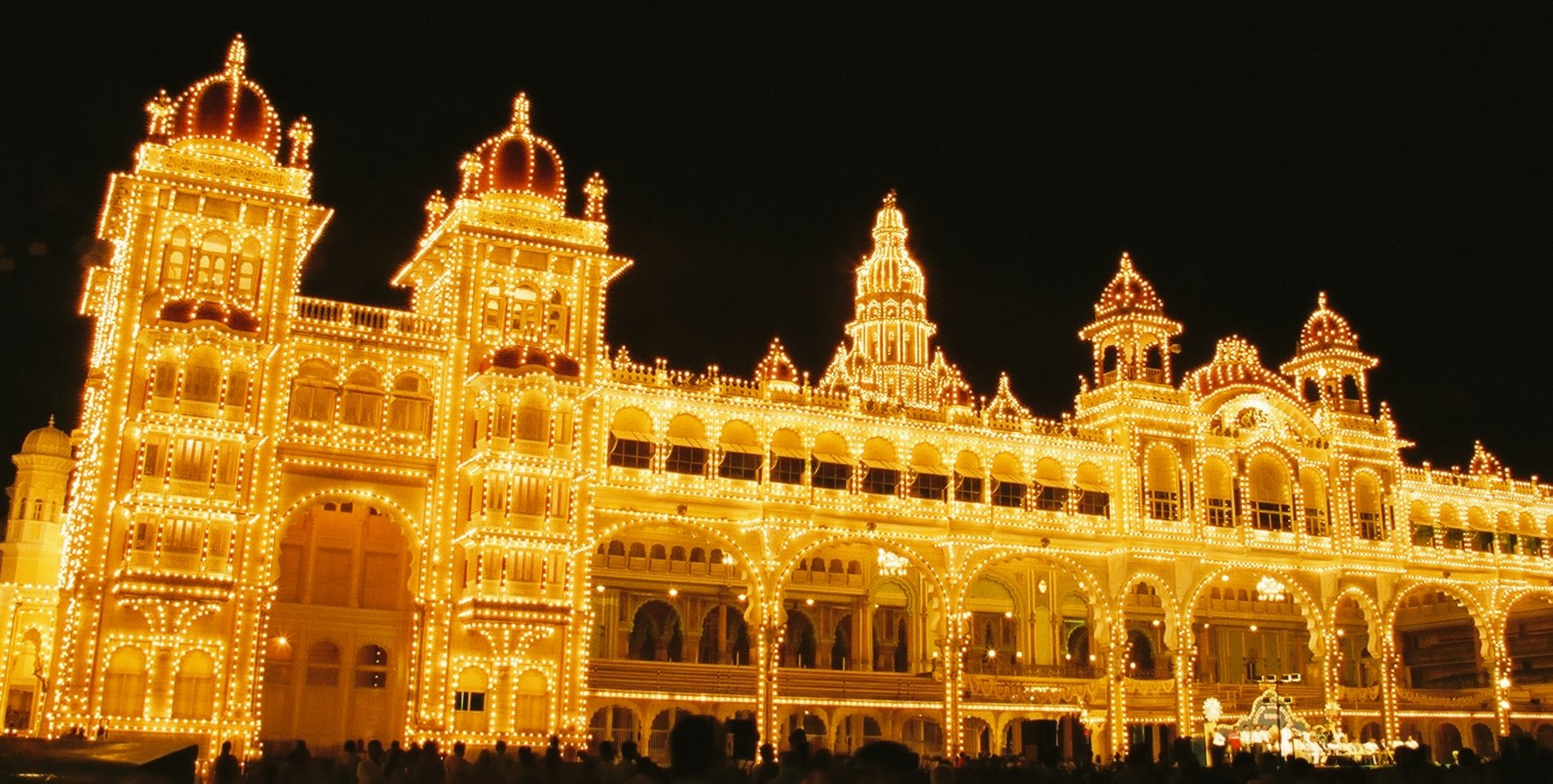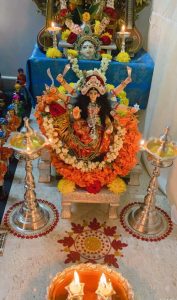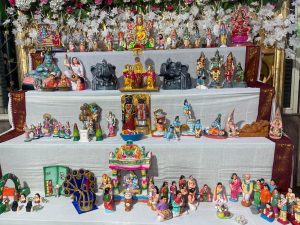Here are some of the ways in which the various regions in South India celebrate Navaratri and Dussehra.

Mysore Palace during Dasara (Creative Commons)
Dussehra, also called Dasara or Vijayadashami, is celebrated on the tenth day following Navaratri with enthusiasm around the country — including in South India, where the nine nights are generally dedicated to Lakshmi, Saraswati, and Durga.
Dussehra is celebrated every year on the tenth day of Shukla Paksha of Ashwina, which according to the Gregorian calendar falls either in September or October. This year, the festival of Dussehra will be celebrated on 5 October 2022 (Wednesday).

Dussehra commemorates Goddess Durga’s victory over Demon Mahishasura (Supplied)
On this day, according to tradition, Lord Rama killed Ravana, and Goddess Durga triumphed over the buffalo Demon Mahishasura. That is why the day is also referred to as the ‘victory of good over evil’. In many parts of the country, the effigies of Ravana, his brother Kumbhakarna, and his son Meghnatha are burnt using fireworks. This symbolises the conquering of darkness by light. Ramlila is organised for 10 days across the country.
The festival is celebrated in many different ways across India, but its essence remains the same — the triumph of good over bad and the start of all new beginnings. There are several mythological stories associated with the festivals.
According to the scriptures, it was on this day that Lord Rama defeated the 10-headed Demon King Ravana after nine days of a fierce battle. Dussehra is derived from the Sanskrit words Dasha (ten) and Hara (defeat) (defeat of ten-headed Ravana).
Dussehra also commemorates Goddess Durga’s victory over Mahishasura, a half-human, half-buffalo demon. Mahishasura, who got a boon from Lord Brahma that no man or God could kill him, started misusing his powers and created terror for everyone. Lords Vishnu, Shiva, and Brahma combined all their powers to create a female form called Durga.
She killed the demon using her trishula (trident) on Vijayadashami after a nine-day-long battle and protected the world, which is now celebrated as Navaratri throughout India.
Devotees worship the nine forms of Goddess Durga during Navaratri, which this year begins on 26 September 2022, and lasts till 5 October 2022. The nine days of worship of Goddess Durga end with the immersion of Her idols in the nearby river, sea, or ocean.
The slaying of Mahishasura also gave the city Mysuru its name. Today, Mysore Dasara, also known as ‘Mysuru Dasara,’ is known worldwide for its grandeur and festivities carried out over the 10 days. It is celebrated in the state as ‘Nada Habba’, which translates to the festival in which citizens of Karnataka take pride.
In the Mysuru tradition, they celebrate the warriors fighting evil and ritually worship and display the state sword, weapons, elephants, horses, and Goddess Durga in her warrior form along with Vishnu avatar Rama.
The city of Mysuru has a 400-year-long tradition of celebrating the Dasara festival. Various cultural programmes are arranged in and around the palace. The highlight of the festival is the procession that is carried out on the ninth day with the idol of Goddess Chamundeshwari. The idol of the Goddess Durga in Mysuru Dasara is made entirely of gold and weighs about 750 kg.
One of the town’s main attractions, the Mysuru Palace is lit with over 1,00,000 bulbs and flowers where “Jamboo Savari”, a famous procession, takes place. It involves elephant parades in which one of the jumbos carries the Goddess Chamundeswari.
The 10-day festivities also include magnificent processions, cultural events, fairs, exhibitions, Yakshagana, Karnataka’s traditional theatre, traditional dances, exhibitions, wrestling, and many other performances displaying or highlighting Karnataka’s culture and heritage. President Droupadi Murmu inaugurated the start of 10-day Dasara festival in Mysuru.
President Droupadi Murmu inaugurated the Mysuru Dasara Festival at Chamundi Hills, Mysuru. pic.twitter.com/SDMjFb8aVk
— President of India (@rashtrapatibhvn) September 26, 2022
All parts of the country celebrate the festival in their own unique ways. The north of India observes various forms of fasts for nine days during Navaratri, Garba — a popular dance form — is played by western India to welcome the presence of the Goddess. The East worships Goddess Durga in all Her glory and many South Indian households celebrate Dussehra with Bommai Golu or Kolu — a decorated display of dolls and figurines. Even with varied rituals, the essence of Dussehra remains consistent.
Today marks the first day of Navaratri (or 9 holy nights) in Hindu Calendar.
These 9 nights celebrate Goddesses in Hinduism. While many communities celebrate it in their own way, my community celebrates it by setting up an arrangement of dolls called Golu #Golu #Navaratri pic.twitter.com/ObdDTNDKSK
— Shreeniwas Iyer (@shreeni) September 26, 2022
Andhra Pradesh, Tamil Nadu, and Karnataka bring in the festival by placing dolls of various Gods, Goddesses, animals, men, and children. In Telugu, Bommala Koluvu means court of toys, in Kannada, Bombe Habba means doll festival and in Tamil, Bommai Golu or Kolu suggests the presence of a divine force.
Over the weekend, I enjoyed visiting the display of #Golu in #Mylapore for #Navaratri. Loved the colours and the tradition of storytelling with figurines & dolls – I even bought a few to display at home.#Chennai #FestivalsofSouthIndia #Navratri pic.twitter.com/ap0QVZhWSu
— Aus Consulate Chennai (@AusCGChennai) September 26, 2022
While many families place nine steps, each step representing the nine days of Navaratri, some keep three, five, or even seven. The steps are covered with a decorative cloth and the dolls are placed on them. The number of dolls kept can vary from one to 11 but they are mostly odd numbers.

Dolls of Gods, Goddesses, animals, men, and children, mythological characters are displayed (Supplied)
It is a display of dolls of mythological characters, animals, birds, artisans, and even movie stars and political leaders. It is not uncommon to find dolls of Gandhi, Nehru, Subhas Chandra Bose, and others on display. These dolls are passed on from one generation to another and it is customary to add at least one new doll every year, representing progress and growth.
The first step has the kalasha (ceremonial jar) filled with water. It is decorated with mango leaves and a coconut is placed on top of it.
This kalasha represents the Goddess Durga. Devotees draw colourful rangolis, light lamps, perform aarti, recite shlokas, and offer special dishes, sweets and fruits every day. Married women and children, especially little girls, are called in and then honoured by gifting betel leaves, coconuts, fruits, flowers, bangles, turmeric, kumkum, and prasad.
Tamil Nadu celebrates the festival by dedicating the nine days to all three Goddesses — Lakshmi, Durga, Saraswati, and worships them for three days each. The celebrations start in Tamil Nadu by setting up these dolls on a makeshift staircase called Kolu at homes, shops, and temples.
Sundal, a delicacy made of groundnut and mixture of pulses, is prepared for the feast. Many devotees visit the Mutharamman temple in Kulasekharapattinam dressed as different forms of the Devi.
Music and dance festivals are organised in temples. Pulikali (tiger dance) is performed in several villages of South Tamil Nadu. Performers paint themselves as tigers and dance to the beats of instruments. A famous dance form Kai silambu attam is performed in temples. The dancers perform by wearing ankle bells and silambu (anklets) in their hands.
In Karnataka, Gombe Habba, the festival of dolls is celebrated by placing dolls of all kinds and of different themes in their house on a step-like set-up.
Very similar to Tamil Nadu’s Golu dolls, these dolls are placed in multiple levels, usually around nine, representing the nine days of Navaratri.
The decorated dolls are placed in homes and people exchange coconuts, clothes, and sweets among themselves. Many devotees from all parts of the state visit the famous Kollur Mookambika temple located in Udupi.
Navaratri in Kerala is centered around Goddess Saraswati and the idea that knowledge is divine power. On the evening of Durgashtami, Pookavaippu is performed, which marks the beginning of important things.
People observe Saraswati Puja or Ayudha Puja on Mahanavami. All the books, instruments, and tools in the house are kept in front of the deity in their homes or temples. This is also marked in other states like Tamil Nadu.
The books and tools are removed on Viayadasami and small children between the age of 2-6 are brought into the world of knowledge by following a ritual of writing on sand or a plate of rice. This ritual is known as Vidyarambham.
Devotees in and around Kerala visit the Thunchan Parambu in Malappuram, Attukal Bhagavathy Temple in Thiruvananthapuram, and Guruvayur Sree Krishna Temple in Thrissur to commemorate the festival.
In Telangana, the Bathukamma, or ‘festival of flowers’ is celebrated for nine days during Navaratri. It is dedicated to the Goddess Durga. Finally, the Bathukammas, or stacks of flowers arranged in the form of a gopuram, are immersed in water.

Jul 26, 2024

Jul 25, 2024

Jul 25, 2024

Jul 25, 2024

Jul 25, 2024

Jul 24, 2024